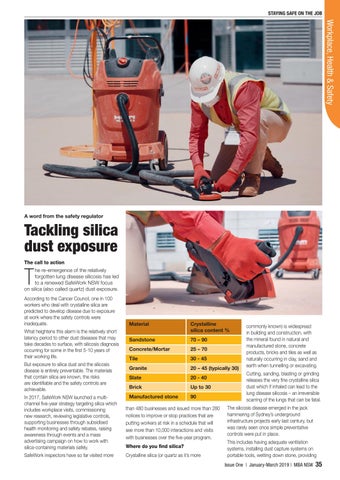STAYING SAFE ON THE JOB
Contents Workplace, Health & Safety
A word from the safety regulator
Tackling silica dust exposure The call to action
T
he re-emergence of the relatively forgotten lung disease silicosis has led to a renewed SafeWork NSW focus on silica (also called quartz) dust exposure. According to the Cancer Council, one in 100 workers who deal with crystalline silica are predicted to develop disease due to exposure at work where the safety controls were inadequate. What heightens this alarm is the relatively short latency period to other dust diseases that may take decades to surface, with silicosis diagnosis occurring for some in the first 5-10 years of their working life. But exposure to silica dust and the silicosis disease is entirely preventable. The materials that contain silica are known, the risks are identifiable and the safety controls are achievable.
Material Crystalline commonly known) is widespread silica content % in building and construction, with Sandstone
70 – 90
Concrete/Mortar
25 – 70
Tile
30 - 45
Granite
20 – 45 (typically 30)
Slate
20 - 40
Brick
Up to 30
Manufactured stone
90
In 2017, SafeWork NSW launched a multichannel five-year strategy targeting silica which includes workplace visits, commissioning new research, reviewing legislative controls, supporting businesses through subsidised health monitoring and safety rebates, raising awareness through events and a mass advertising campaign on how to work with silica-containing materials safely.
than 480 businesses and issued more than 280 notices to improve or stop practices that are putting workers at risk in a schedule that will see more than 10,000 interactions and visits with businesses over the five-year program.
SafeWork inspectors have so far visited more
Crystalline silica (or quartz as it’s more
Where do you find silica?
the mineral found in natural and manufactured stone, concrete products, bricks and tiles as well as naturally occurring in clay, sand and earth when tunnelling or excavating. Cutting, sanding, blasting or grinding releases the very fine crystalline silica dust which if inhaled can lead to the lung disease silicosis – an irreversible scarring of the lungs that can be fatal.
The silicosis disease emerged in the jack hammering of Sydney’s underground infrastructure projects early last century, but was rarely seen once simple preventative controls were put in place. This includes having adequate ventilation systems, installing dust capture systems on portable tools, wetting down stone, providing Issue One | January-March 2019 | MBA NSW
35




